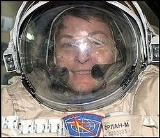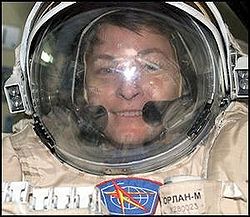
Expedition 5
Encyclopedia
Expedition 5 was the fifth long-duration stay on the International Space Station
(ISS). The crew, consisting of three people, remained in space for 184 days, 178 of which were spent aboard the ISS. Expedition 5 was a continuation of an uninterrupted human presence in space, as of March 2011, which was begun by Expedition 1
in 2000-2001.
The crew of Expedition 5 launched to space aboard the Space Shuttle Endeavour
aboard the STS-111
mission on June 5, 2002. Their tenure aboard the station, however, did not occur until they docked with the ISS two days later on June 7.

7 December 2002.
Space Shuttle Endeavour delivered the Expedition 5 crew during mission STS-111
which launched 5 June 2002. The fifth crew to live aboard the International Space Station was led by Russian Valery Korzun and joined by fellow Cosmonaut Sergei Treshchev and U.S. Astronaut Peggy A. Whitson, both flight engineers. While onboard, Dr. Whitson was named NASA's first ISS Science Officer by NASA Administrator O'Keefe.
International Space Station
The International Space Station is a habitable, artificial satellite in low Earth orbit. The ISS follows the Salyut, Almaz, Cosmos, Skylab, and Mir space stations, as the 11th space station launched, not including the Genesis I and II prototypes...
(ISS). The crew, consisting of three people, remained in space for 184 days, 178 of which were spent aboard the ISS. Expedition 5 was a continuation of an uninterrupted human presence in space, as of March 2011, which was begun by Expedition 1
Expedition 1
Expedition 1, or Expedition One, was the first long-duration stay on the International Space Station . The three-person crew stayed aboard the station for 136 days, from November 2000 to March 2001. It was the beginning of an uninterrupted human presence on the station which still continues, as of...
in 2000-2001.
The crew of Expedition 5 launched to space aboard the Space Shuttle Endeavour
Space Shuttle Endeavour
Space Shuttle Endeavour is one of the retired orbiters of the Space Shuttle program of NASA, the space agency of the United States. Endeavour was the fifth and final spaceworthy NASA space shuttle to be built, constructed as a replacement for Challenger...
aboard the STS-111
STS-111
STS-111 was a space shuttle mission to the International Space Station flown by Space Shuttle Endeavour. STS-111 resupplied the station and replaced the Expedition 4 crew with the Expedition 5 crew...
mission on June 5, 2002. Their tenure aboard the station, however, did not occur until they docked with the ISS two days later on June 7.
Crew
Mission parameters
- PerigeePerigeePerigee is the point at which an object makes its closest approach to the Earth.. Often the term is used in a broader sense to define the point in an orbit where the orbiting body is closest to the body it orbits. The opposite is the apogee, the farthest or highest point.The Greek prefix "peri"...
: 384 km - Apogee: 396 km
- InclinationInclinationInclination in general is the angle between a reference plane and another plane or axis of direction.-Orbits:The inclination is one of the six orbital parameters describing the shape and orientation of a celestial orbit...
: 51.6° - PeriodOrbital periodThe orbital period is the time taken for a given object to make one complete orbit about another object.When mentioned without further qualification in astronomy this refers to the sidereal period of an astronomical object, which is calculated with respect to the stars.There are several kinds of...
: 92 min

Mission objectives
The Expedition Five crew took charge of ISS operations on 7 June 2002. An official ceremony between Expedition crews took place 10 June, with the ceremonial ringing of the station's brass bell, symbolizing the transfer of command. The Expedition Five crew carried out approximately 25 new investigations onboard the ISS, as well as continued with various science investigations begun before their stay. The crew wrapped up a 185-day stay in space when they returned home on STS-113STS-113
STS-113 was a Space Shuttle mission to the International Space Station flown by Space Shuttle Endeavour. During the 14-day mission in late 2002, Endeavour and its crew extended the ISS backbone with the P1 truss and exchanged the Expedition 5 and Expedition 6 crews aboard the station...
7 December 2002.
Space Shuttle Endeavour delivered the Expedition 5 crew during mission STS-111
STS-111
STS-111 was a space shuttle mission to the International Space Station flown by Space Shuttle Endeavour. STS-111 resupplied the station and replaced the Expedition 4 crew with the Expedition 5 crew...
which launched 5 June 2002. The fifth crew to live aboard the International Space Station was led by Russian Valery Korzun and joined by fellow Cosmonaut Sergei Treshchev and U.S. Astronaut Peggy A. Whitson, both flight engineers. While onboard, Dr. Whitson was named NASA's first ISS Science Officer by NASA Administrator O'Keefe.
Spacewalks
The Expedition Five crewmembers conducted two spacewalks during their stay at the International Space Station. Both were based out of the Pirs Docking Compartment and used Russian Orlan space suits.| Mission | Spacewalkers | Start (UTC Coordinated Universal Time Coordinated Universal Time is the primary time standard by which the world regulates clocks and time. It is one of several closely related successors to Greenwich Mean Time. Computer servers, online services and other entities that rely on having a universally accepted time use UTC for that purpose... ) |
End (UTC) | Duration |
|---|---|---|---|---|
| Expedition 5 EVA 1 |
Valery Korzun Valery Korzun Valery Grigoryevich Korzun is a Russian cosmonaut of Ukrainian descent. He has been in space twice totalling 381 days. He has also conducted four career spacewalks.- Personal :... Peggy Whitson Peggy Whitson Peggy Annette Whitson is an American biochemistry researcher, NASA astronaut, and NASA's Chief Astronaut. Her first space mission was in 2002, with an extended stay aboard the International Space Station as a member of Expedition 5. Her second mission launched October 10, 2007, as the first female... |
16 August 2002 09:23 |
16 August 2002 13:48 |
4 hours, 25 minutes |
| Korzun and Whitson installed six debris panels onto the Zvezda Service Module. They removed the panels from their temporary location on the station's Pressurized Mating Adapter Pressurized Mating Adapter The International Space Station uses three Pressurized Mating Adapters to interconnect spacecraft and modules with different docking mechanisms. The first two PMAs were launched with the Unity module in 1998 aboard STS-88... 1 prior to attachment to Zvezda. The panels are designed to shield Zvezda from potential space debris impacts. A total of 23 shields will eventually be installed onto the Service Module. |
||||
| Expedition 5 EVA 2 |
Korzun Sergei Treshchev |
26 August 2002 05:27 |
26 August 2002 10:48 |
5 hours, 21 minutes |
| During Expedition Five's second spacewalk, Korzun and Treshchev installed a frame on the outside of the Zarya Module to house components for future spacewalk assembly tasks. They installed new material samples on a pair of Japanese Space Agency materials exposure experiments housed on the outside of Zvezda. Korzun and Treshchev also installed devices on Zvezda that will simplify the routing of tethers during future assembly spacewalks. They improved future station amateur radio operations by adding two ham radio antennas on Zvezda. Also, Korzun and Treshchev installed the Kromka hardware that was originally slated to take place during Expedition Five's first spacewalk. Kromka measures residue emissions from Zvezda's jet thrusters. | ||||

